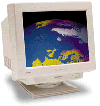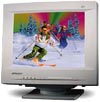Monitor
Page
Description:
Monitors can run at
various different resolutions and refresh rates. 640x480 is the
default resolution for the Windows operating systems. Most users
prefer higher resolutions such as 800x600 or 1024x768 all the way up to
1920x1200. The higher resolutions make the picture smaller, but
clearer. You can fit more on a screen when it is in a higher
resolution. Larger monitors are needed to run at the higher
resolutions. The refresh rate is how fast the monitor can refresh
(redraw) the images on the screen. The faster it can do this, the
smoother your picture will be and the less "flicker" you will
see.
What To Look
For:
- First,
consider the monitor size that you want. The larger you can
get, the happier you will be. The monitor is the one part that
you can keep with you through all the times you upgrade your
computer or purchase a new computer, so it doesn't hurt to spend the
extra money once on a monitor you will be happy with for awhile.
15" is considered the bare minimum anymore. 17"
monitors are becoming standard. The relatively new 19"
monitors provide a nice large screen at a fairly cheap price, and
they don't take up a huge space on your desk either. Anything
above 19" is pure luxury and not really needed unless you're
into graphic design, etc.
- The
dot pitch of the monitor is one of the most important things to look
for when considering a new monitor. It basically shows how
clear the picture will be (higher dot pitch numbers may provide a
fuzzy image). Anything at .26 mm dot pitch should be fine for
most users and .28 is okay for smaller monitors. Pay attention
to how the dot pitch is measured. It can be written as
horizontal, vertical, or other forms. Usually horizontal is
used, but avoid or at least question monitors that present different
measurements for the dot pitch.
- Look
for monitors that support fairly high resolutions for their size.
Consider, however, that it is impossible for a small 14"
monitor to display at 1600x1200 resolution (same for a 15").
17" monitors are about the minimum to be able to run at
1024x768 comfortably. A 15" monitor can usually do
1024x768, but objects are small and somewhat hard to see.
- Higher
refresh rates will definitely make computer work easier on your
eyes. Consider 75-85 Hz as a minimum refresh rate for any
resolution that you actually plan to run your monitor at.
Anything above 85 is a nice bonus... Make sure your video
card will support the higher refresh rates and resolutions.
Recommendations:
- 6/16/00
Update- Mitsubishi now has a new line of Diamondtron monitors that
may be worth trying. If money's no object, then the Mitsubishi
22" Diamond Pro 2040U is the best you can get, but expect to
spend a little over $1,000! Not bad though, since it's better
than the 21" GDM-F500 which costs closer to $1,600!
I have now used a lot of the 19" monitors, and this is the
order in which I would recommend them. Some of them are
expensive, but have *very* nice picture quality.
- Sony
GDM-F400 ($830 = lowest price). This is simply the best.
.22 dpi, completely flat Trinitron, Sony's newest and greatest
technology, which the price tag reflects.
- Princeton
Graphics AGX900 ($436 = lowest price). This is by far
the best 19" monitor for the price. This one is .25 dpi
and is based on a Sony Trinitron tube. It is just as nice as
the Sony GDM-400PS (not the same as the one above), but much less
expensive.
- Viewsonic
PS790 is a great monitor at a great price. There has been a
$100 rebate on it, but I'm not sure how much longer that is good
for. Check at Viewsonic's website.
- Philips
Brilliance 109 ($449 = lowest price). This is also a
nice monitor and comes with a USB hub, but it doesn't compare to
the Trinitron technology. Since there is only a $32
difference in price, get the Princeton Graphics one.
- ADI
Microscan 6P ($392 = lowest price). This is also a nice
19" monitor and comes with a USB hub. If you want to
save money, this would be a good one to get.
- Optiquest
V95 ($355 = lowest price). This one is comparable to the ADI
in price and picture. The ADI has more features, so I would
pick it over the Optiquest.
- 10/10/99
Update- For 17" monitors, I prefer the Sony 210-GS Trinitron
monitor or the AcerView 78C non-Trinitron monitor. Both have
great displays and great prices. Trinitrons generally have the
better brightness and color quality.
- OLD:
A new number one: Philips' Brilliance 109. From what
I've heard, it is better than the ADI and Optiquest 19"
monitors. It has a .22 dpi (some places write that it is .24,
others .26) and does 1600x1200 at 75 Hz and 1024x768 at 115 Hz.
Update: I now own this monitor and the hype is true. It
does have a sharper picture than the Optiquest and ADI.
However, it does seem to have a rougher display than the others.
I guess I could explain it as the grill being less fine.
Though text is easier to read, up and down lines seem a little more
jagged. The Philips also has a microphone, speakers, great
controls, USB hub (optional), microphone and headphone jacs, etc.
The speakers are junk, but it doesn't hurt to have them.
seem a little more
jagged. The Philips also has a microphone, speakers, great
controls, USB hub (optional), microphone and headphone jacs, etc.
The speakers are junk, but it doesn't hurt to have them.
- My
second pick for value and quality is the ADI Microscan 6P.
It's a 19" monitor at a 17" price (it can be found just
over $500). It's a .26 mm dot pitch monitor and does 1600x1200
at 75 Hz. In addition, it has USB ports and a built-in
microphone. In my opinion, there is no point in getting a
17" monitor (or even a good 15") when you can get this one
so cheap.
-
 The
Iiyama 9017 E (Vision Master Pro) is one of the best 17"
monitors. It will do 1600x1200 resolutions at 72 Hz, not bad
for a 17" monitor. It's a .25 mm dot pitch and has a
great picture quality. It is relatively expensive though.
The
Iiyama 9017 E (Vision Master Pro) is one of the best 17"
monitors. It will do 1600x1200 resolutions at 72 Hz, not bad
for a 17" monitor. It's a .25 mm dot pitch and has a
great picture quality. It is relatively expensive though.
- If
you can't afford the Iiyama, then Acer makes some incredible
monitors for the price. The 17" 76e is about their
cheapest one, but it doesn't look bad at all. The 78c has an
incredibly good image quality. Text is beautiful too. It
has about the best picture quality of any monitor I have ever seen
(except the Iiyama) and last time I checked it was only about $330.
It may have been discontinued though as it is no longer listed on
Acer's website. It appears to have been replaced by the 78ie
which has about the same features. Another quality, low-priced
17" monitor worth mentioning is Princeton Graphics' Ultra 75.
-
 Another
good value is the 15" Optiquest Q53 monitor (made by ViewSonic)
which does have a .28 mm dot pitch (not great), but it does have a
nice clear picture for the price.
Another
good value is the 15" Optiquest Q53 monitor (made by ViewSonic)
which does have a .28 mm dot pitch (not great), but it does have a
nice clear picture for the price.
- Other
monitor brands to consider are ViewSonic, Hitachi, and Sony, but
these are all fairly expensive.
 seem a little more
jagged. The Philips also has a microphone, speakers, great
controls, USB hub (optional), microphone and headphone jacs, etc.
The speakers are junk, but it doesn't hurt to have them.
seem a little more
jagged. The Philips also has a microphone, speakers, great
controls, USB hub (optional), microphone and headphone jacs, etc.
The speakers are junk, but it doesn't hurt to have them.  The
Iiyama 9017 E (Vision Master Pro) is one of the best 17"
monitors. It will do 1600x1200 resolutions at 72 Hz, not bad
for a 17" monitor. It's a .25 mm dot pitch and has a
great picture quality. It is relatively expensive though.
The
Iiyama 9017 E (Vision Master Pro) is one of the best 17"
monitors. It will do 1600x1200 resolutions at 72 Hz, not bad
for a 17" monitor. It's a .25 mm dot pitch and has a
great picture quality. It is relatively expensive though.
 Another
good value is the 15" Optiquest Q53 monitor (made by ViewSonic)
which does have a .28 mm dot pitch (not great), but it does have a
nice clear picture for the price.
Another
good value is the 15" Optiquest Q53 monitor (made by ViewSonic)
which does have a .28 mm dot pitch (not great), but it does have a
nice clear picture for the price.